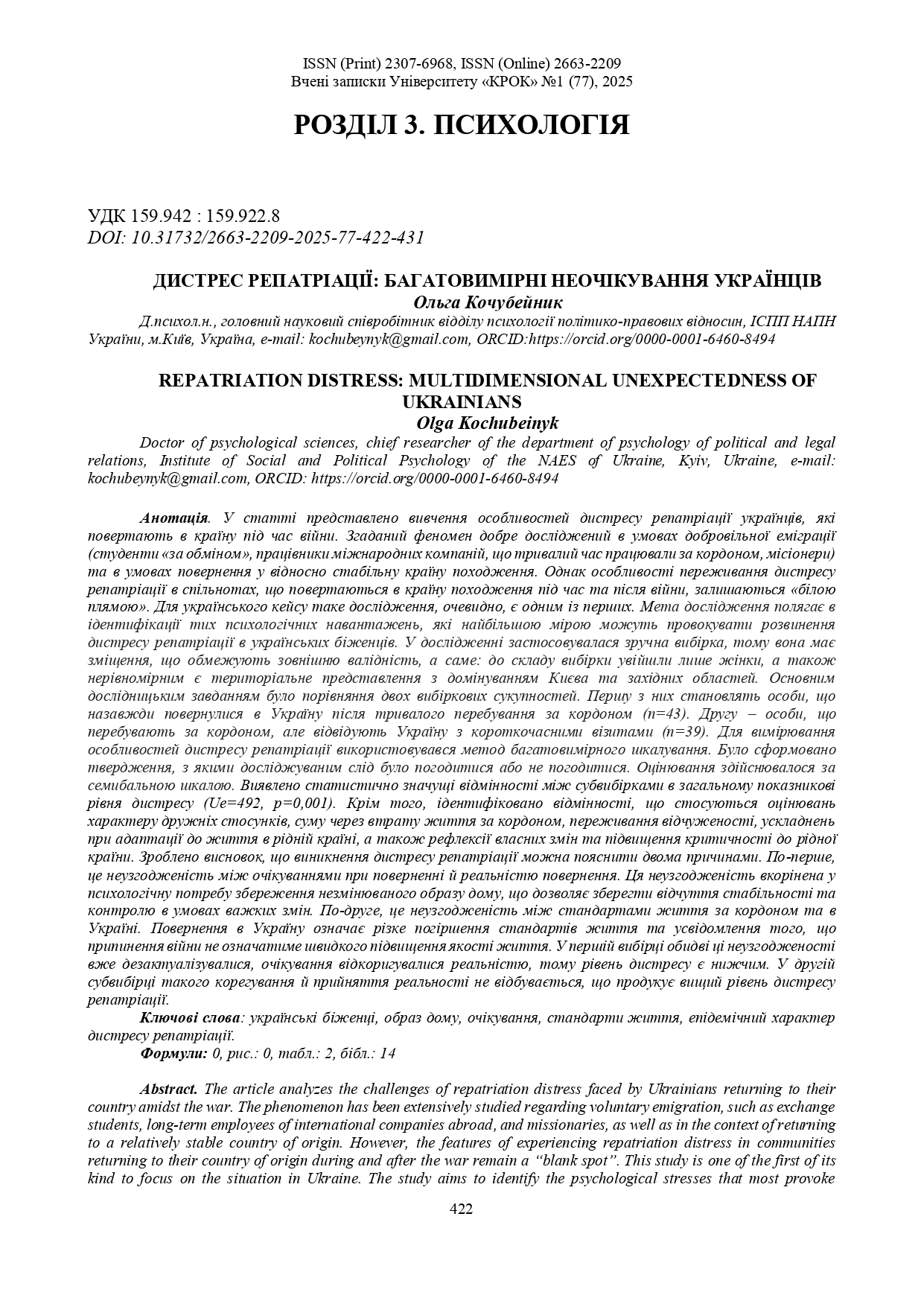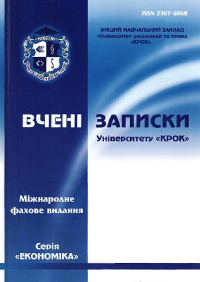REPATRIATION DISTRESS: MULTIDIMENSIONAL UNEXPECTEDNESS OF UKRAINIANS
DOI:
https://doi.org/10.31732/2663-2209-2025-77-422-431Keywords:
Ukrainian refugees, image of home, expectations, standards of living, epidemic character of repatriation distressAbstract
The article analyzes the challenges of repatriation distress faced by Ukrainians returning to their country amidst the war. The phenomenon has been extensively studied regarding voluntary emigration, such as exchange students, long-term employees of international companies abroad, and missionaries, as well as in the context of returning to a relatively stable country of origin. However, the features of experiencing repatriation distress in communities returning to their country of origin during and after the war remain a “blank spot”. This study is one of the first of its kind to focus on the situation in Ukraine. The study aims to identify the psychological stresses that most provoke repatriation distress in Ukrainian refugees. The study used a convenient sampling method. The sample has biases that limit its external validity. Specifically, the sample included only women, and there is uneven territorial representation, with an overrepresentation of Kyiv and the western regions. The primary research objective was to compare two sample populations. The first sampling consists of individuals who have permanently returned to Ukraine after a long stay abroad (n=43). The second sampling consists of individuals who are abroad but visit Ukraine for short-term visits (n=39). To measure the features of repatriation distress, statements were formed with which the subjects had to agree or disagree. The assessment was carried out on a seven-point Likert scale. Statistically significant differences were found between the subsamples in the general indicator of the level of distress (Ue=492, p=0.001). In addition, differences were identified regarding assessments of friendly relations, sadness due to the loss of life abroad, experiences of alienation, difficulties in adapting to life in the home country, as well as reflection on one's own changes and increased criticality towards the home country. It is shown that the emergence of repatriation distress can be explained by two reasons. First, it is a discrepancy between expectations upon return and the reality of return. This discrepancy is rooted in the psychological need to preserve an unchanging image of home, which allows one to maintain a sense of stability and control in difficult changes. Second, there is a discrepancy between the standards of living abroad and in Ukraine. Returning to Ukraine indicates a significant decline in living standards, and it becomes clear that the end of the war will not lead to a swift improvement in the quality of life. In the first sample, these discrepancies have already been de-actualized, and expectations have been adjusted by reality, so the level of distress is lower. In the second subsample, such adjustment and acceptance of reality does not occur, which produces a higher level of repatriation distress.
Downloads
References
Allison, P., Davis-Berman, J. & Berman, D. (2011). Changes in latitude, changes in attitude: Analysis of the effects of reverse culture shock - a study of students returning from youth expeditions. Leisure Studies. 31. 487–503. 10.1080/02614367.2011.619011.
Berry, J. W. (1997). Immigration, acculturation, and adaptation. Applied Psychology: An International Review, 46(1), 5–34.
Black, J. S., Gregersen, H. B., & Mendenhall, M. E. (1992). Global Assignments: Successfully Expatriating and Repatriating International Managers. Jossey Bass Business & Management Series.
El-Asri, S., Karfa, E., & Farhane, H. (2024). Dealing with Reverse Culture Shock after Cultural Exchange: Contributing Factors and Coping Strategies. Journal of Psychology and Behavior Studies. 4. 51–56. 10.32996/jpbs.2024.4.1.6.
Gaw, K. F. (2000). Reverse culture shock in students returning from overseas. International Journal of Intercultural Relations, 24, 83–104.
Gullahorn, J. E., & Gullahorn, J. T. (1963). An extension of the U‐curve hypothesis. Journal of Social Issues, 19, 33–47.
Luo, J., & Jamieson-Drake, D. (2015). Predictors of study abroad intent, participation, and college outcomes. Research in Higher Education, 56(1), 29–56. https://doi.org/10.1007/s11162-014-9338-7
Lysgaard, S. (1955). Adjustment in a foreign society: Norwegian Fulbright grantees visiting the United States. International Social Science Bulletin, 7, 45–51.
MacDonald, S., & Arthur, N. (2003). Employees' perceptions of repatriation. Canadian Journal of Career Development, 2(1), 3–11.
Sahin, N. H. (1990). Re-entry and the academic and psychological problems of the second generation. Psychology and Developing Societies, 2(2), 165–182.
Storti, C. (2003). The art of coming home. Nicholas Brealey Publishing.
Sussman, N. M. (2002). Testing the cultural identity model of the cultural transition cycle: Sojourners return home. International Journal of Intercultural Relations, 26(4), 391–408. https://doi.org/10.1016/S0147-1767(02)00013-5
Young, G. E. (2014). Reentry: Supporting students in the final stage of study abroad. New Directions for Student Services, 146, 59–67. https://doi.org/10.1002/ss.20091

Downloads
Published
How to Cite
Issue
Section
License

This work is licensed under a Creative Commons Attribution-NonCommercial 4.0 International License.

